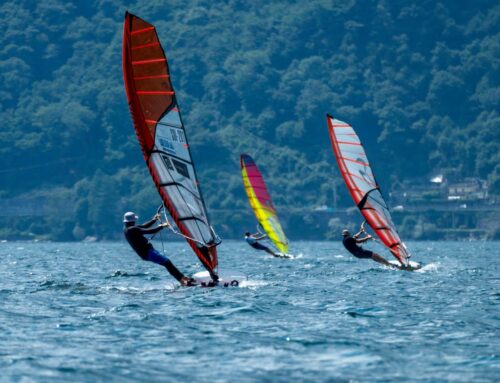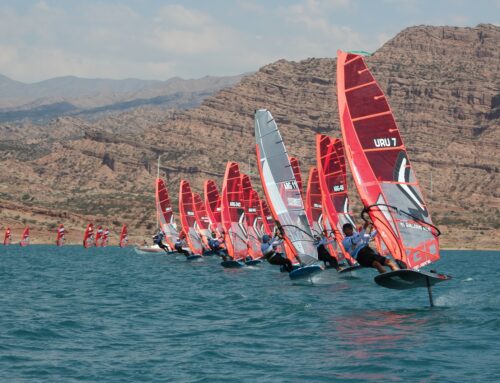Allison Shreeve, a member of the FOD Steering Committee, has asked me to post this letter in response to many forum postings. I do not know if you follow “forum” postings, but the “RSX or FOD for 2012” debate has certainly stimuated a lively reaction on many forums! Forums often throw up many misleading statements from “unqualified” commentators . However it enables one to focus on the core facts – which is the reason for this letter.
Allison has proven that FW, particularly the Formula One Design, is not a “heavyweights only” class for either men or women ! Current olympic class competitors can compete with the average weight racers that only compete in formula events. How else could Marta Hlavaty (POL) and Olga Maslivets (UKR) finish 1st and 3rd respectively in 2008 FW Worlds.! I have attached a short analysis of mens weight groups in FW.
Kind regards,
Ceri Williams.
Hi All,
There seems to be a lot of speculation as to if the FOD kit can be planed or even raced in 6 knots. I have proved that this again and again in 5 regattas this year against open mens fleets. To put some things into perspective…
1) I have got planing on the FOD 9.5m women’s and the FOD 11m mens kits in 5 knots. Some wind readings were 4-6knots at the time from the boat anchored (not drifting!). I did this in Portugal in April, in UK, Poland and in US in May. It was flat water, small chop, and swelly conditions.
2) I had to pump to get onto the plane, perhaps 4-6 pumps and I can hook in depending on wave conditions. Maybe if there were wind shaddows of other boards up to 8 pumps. Once planing I can hook in and only needed to pump in lulls, or out of tacks and gibes.
3) I have raced in 6 knots in the open mens fleets at these regattas with both the 9.5m and 11m rigs, to prove that it can be raced in these conditions. In fact my best results were in the lighter wind on the FOD gear.
4) I am the heaviest in the womens fleet, so if I can get planing in 5-6knots with the 9.5 then I’m sure the girls 10-15kg lighter than me will have no problems. All the RS:X sailors know how to pump, so they will find it very easy to race and to get planing in fleet situations. If you can sail an RS:X you can sail anything. The trick with Formula is to not sail out of the gusts when its light wind.
5) With regards to efficiency around the course, we did a marathon in the US, I came 3rd out of the open Formula’s and overall my time being about 1 hour. The next best R:SX and long boards finished 30min behind. This was in conditions from 2-9knots with over 100 boards on the line taking everyones wind for a down wind start!
6) There are a lot of sailors and people out there judging the FOD kit without even trying it first. Not only more fun than RS:X, but more efficient, more fun, less injuries, 2/3 of the price, easier to carry therefore less damage to gear at the beach etc, cheaper to travel with baggage requirements, juniors are much more likely to continue with Olympic class with the FOD than with RS:X.
7) One of the best things about the FOD kit is, for those competing for the Olympics, they can train and compete with the open formula fleets, therefore pushing them harder while going up against equipment slightly better. Once the trails are over, they can sell the FOD kit because it is still competetive in the Formula fleet where there are many more sailors would would buy the gear. They can also continue training in their own country instead of nations having to pair up for training partners for lack of people who want to sacrifice 2 years of their life when they know they wont be selected for the Olympics and don’t want to use a board that isn’t fun.
8) Every single one of my RS:X boards delaminated within a year! If federations are worried about investing in a new class, they will have to replace all their RS:X’s soon anyway, so why not replace them with something that is 2/3 of the price!
9) While some people say that there are some places in the world with not much wind, perhaps under 6 knots, then I would say… In Australia, we do not have the best skiing conditions, therefore those who want to go to the Olympics train in other contries with good snow like NZL. We have wonderful conditions for sailing in Australia, yet I have to travel to Europe for competition in RS:X because there are no competitors wanting to race such a heavy board… pretty expensive to live overseas between 6-10months of the year for an Olympic dream, but you do what you have to do. For those who may live in a place where there might be under 6 knots consistantly, perhaps they should buy a long board, or travel to somewhere where there is wind and competition like the rest of us.
10) ISAF rules say racing shouldn’t start unless 6knots from a drifting boat! That means more than 6 knots at times. Formula will have no problems racing and getting regattas in with these conditions.
I hope this helps some of you out there understand a little more about the FOD kit. There is a report on the Formula website with more information regarding pros and cons from Formula and the RS:X kits if you are interested.
My weight changes regularly depending on what class I’m doing and how hard I’m working. For Olympic trials last year I got down to 62kg, but my most comfortable weight is about 70kg. For speed I got up to 73kg.
When I got planing in 5-6knots this year with the 9.5 FOD kit I was at 70kg.
Formula One Design will not eliminate pumping all together. You will still have to pump to get planing, out of transitions like tacks and gibes, through lulls, off the starting line to get the advantage and perhaps if its light wind to get a bit more speed in the lighter patches. We have never claimed that there will be no pumping, so for those people who love pumping so much, don’t worry you will still get your chance.
I don’t think its fair or reasonable in the R:SX class that the women are still track forward centreboard down and pumping until 12 or 13+knots before we get to plane. Not only that, we have to use the beating strap and the front reaching strap to put our feet in while pumping to try and rail the wide board; so our back foot is going in crooked putting a huge amount of pressure on our outer ankles while we are pumping so hard. The men only have to do this until 9 or 10 knots before they get to plane up wind.
Then once we are planing the angles are so low that we have to sail about 1km out to sea to even get to the layline, this is not media friendly or course friendly for those venues who have small areas to race in.
Since 2005 I don’t remember a regatta where we had more than 2 planing races in any competition in RS:X. So for someone who isn’t 55kg, this makes it very hard to be competetive. We would race in the morning when there was no wind “because there was supposed to be no wind in China”, and then sail back in the afternoon in a nice seabreeze. Its time we start racing in wind again and not pushing to race in under 6 knots because we can.
6 knots is not that much wind to wait for. I remember a few years ago, we all used to whistle and bash on our sails so that we wouldn’t race in under 6 knots (This was when when we were on the Mistral One Design). I think its time to go back to the rule of not racing in under 6 knots, and use equipment that is fun, easy to use, competetive with current equipment, efficient and cheap!
Allison Shreeve.
AUS911


